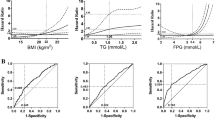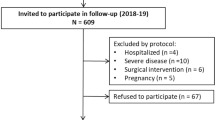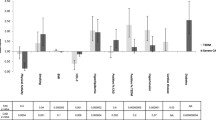Abstract
This study was designed with a follow up of 16 years to provide the epidemiological model evaluating the risk of developing diabetes mellitus in Japan. A cohort of 2573 subjects (1851 males and 722 females) from a MHTS in Tokyo, who were nondiabetic (fasting blood glucose (FBS) less than 110 mg/dl) in the initial year, were selected. This cohort was followed every year to identify the occurrence of diabetes mellitus. Diabetes Mellitus was defined as fasting blood glucose over 110 mg/dl, or the initiation of diabetic therapy. We compared two prognosis groups (a normal group and a diabetic group) in terms of age, examination findings, and prevalence of health risks (lifestyle, stress, and working form). We also assessed family history of diabetes and past histories including hypertension, hypercholesterolemia, and hyperuricemia. After assessing each variable by univariate analysis(t-test, χ 2 test), we employed Cox's proportional hazards model analysis. We used stepwise model adopting risk factors. The diabetic group had significant differences compared to the normal group in age, BMI (body mass index), FBS, smoking, drinking, not eating breakfast, dairy intake, hypertension, hypercholesterolemia, hyperuricemia, and family history by univariate analysis. According to proportional hazards model analysis, FBS, age, family history, hypertension, smoking, and BMI were incorporated into significant risk factors for diabetes in males, and not eating breakfast, FBS, age, drinking, and hypertension were incorporated in females. Diabetes seemed to be related to fixed factors (age), or genetic factors (family history and FBS) in males. For females, lifestyle (not eating breakfast and drinking habit) seemed to play an important role. It will be worthwhile to assess the risks of developing diabetes mellitus by this epidemiological model.
Similar content being viewed by others

REFERENCES
Reports of patients surveillance. Ministry of Health and Welfare, Japan, 1995.
SAS User's Guide: Basics, Ver. 5 Edition North Carolina, SAS Institute Inc., 1985.
SUGI Supplemental Library User's Guide: 1983 Edition North Carolina, SAS Institute Inc., 1983.
National Diabetes Data Group:Classification and diagnosis of diabetes mellitus and other categories of glucose intolerance. Diabetes 28:1039–1057, 1979.
National High Blood Pressure Education Program. The Fifth Report of the Joint National Committee on Detection, Evaluation, and Treatment of High Blood Pressure (NIH Publication No.93–1008), NIH, Bethesda, MD, 1993.
Stampfer, M. J., et al., A prospective study of moderate alcohol drinking and risk of diabetes in women. Am. J. Epidemiol. 128:549–558, 1988.
Author information
Authors and Affiliations
Rights and permissions
About this article
Cite this article
Sugimori, H., Miyakawa, M., Yoshida, K. et al. Health Risk Assessment for Diabetes Mellitus Based on Longitudinal Analysis of MHTS Database. Journal of Medical Systems 22, 27–32 (1998). https://doi.org/10.1023/A:1022650305109
Issue Date:
DOI: https://doi.org/10.1023/A:1022650305109



